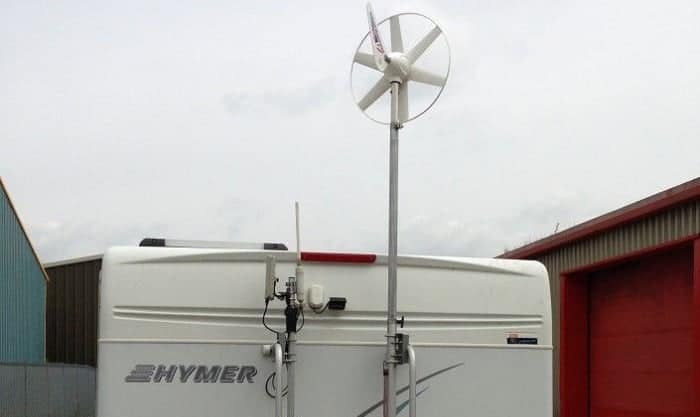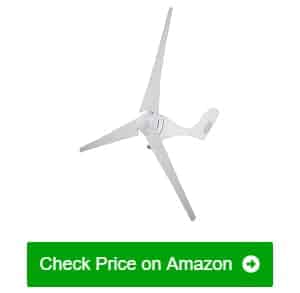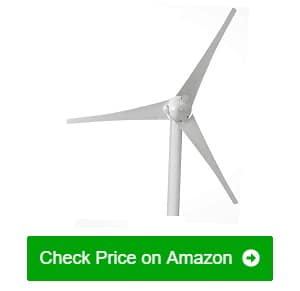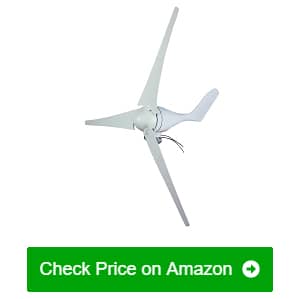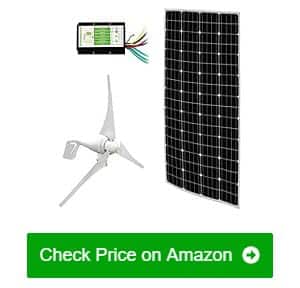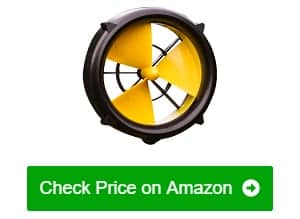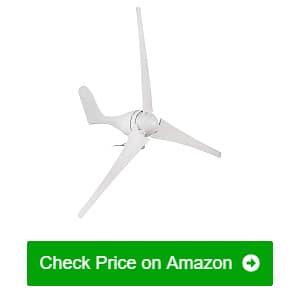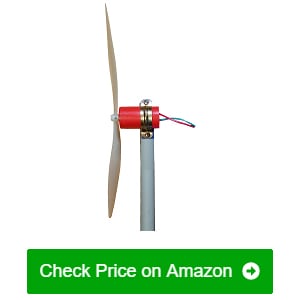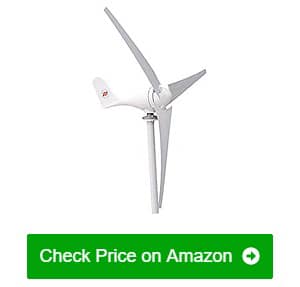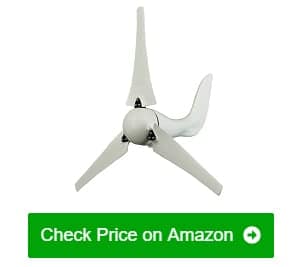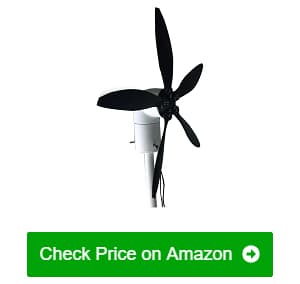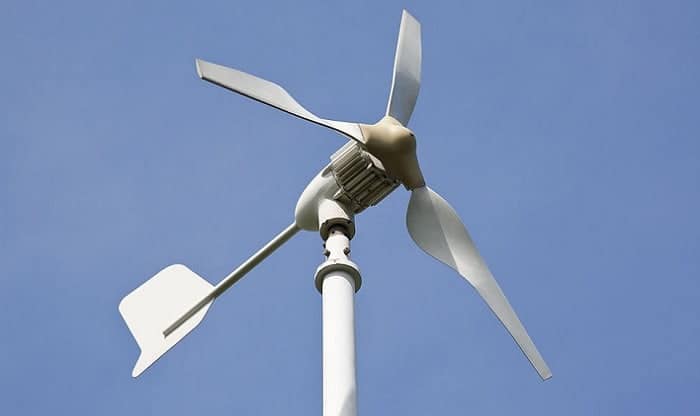Do you often experience an extended RV trip? If you answered yes, then you are probably aware that relying on just the batteries of your RV can be a problem. If you stay in a public trailer park with access to electricity, the cost of plugging into their grid will make you just want to go home.
If you want to save money, and by extension, also help the environment, you need to get the best RV wind turbine. An RV wind generator is like a reversed electric dynamo. Instead of using up electricity to spin the shaft, it is spun in the reverse direction using propellers. This action causes the generator to turn and produce electricity.
You will be harnessing the power of the wind to produce electricity to charge the batteries of your RV continuously. In other words, you will mostly be self-sustaining. However, choosing the right wind turbine for your RV can be a tricky task, primarily because not all manufacturers produce the same quality of the product.
The good news is that you can stop worrying now because this article will teach you all there is to know about portable wind turbines. It even includes a guide that will help you choose the right turbine for your particular needs.
By the end of this article, you will be able to make the right decision regarding your very first RV wind turbine. There is almost a hundred percent guarantee that you will not suffer from buyer’s remorse.
Table of Contents
Best RV Wind Turbine Reviews
1. Happybuy Wind Turbine Generator
One thing that I, as well as many other users, like the most about this RV windmill, is the way its manufacturer took the time to protect it against all kinds of harsh weather. Not only are the components used highly resistant to corrosion, but the sensitive electronics are also enclosed in a completely watertight housing. This housing is also dustproof.
With all these features, there is an assurance that this turbine will last for many years. However, you still need to make sure that the turbine is well-kept and updated in its maintenance works. Another nice feature I genuinely liked is the integrated emergency safety features.
For instance, this wind turbine comes with built-in brakes that aid in slowing down the spinning of the rotor during inclement weather condition. Yes, it is true that the faster the rotor spins, the more electricity the generator produces. However, note that it can only withstand so much stress.
It means that the brakes are still needed to prevent the wind turbine from self-destructing. If you let the blades spin even during high-wind situations, the insane amount of centrifugal will rip them apart, specifically at the seams. The brakes are essential to stop the blades from getting damaged.
The blades of this turbine for wind power for RV are made of very durable injection-molded plastic, 30% of which is carbon fiber for additional strength and significant weight decrease. You can then see the propellers being treated by coating them with a UV-resistant layer to protect them against the damaging rays of the sun.
Without this treatment, the plastic will get brittle after just a couple of months or weeks of sun exposure, making them prone to shattering. Another thing that left a positive impression regarding this product is that it comes with a charging controller. This feature cuts off the batteries when they are already charged to capacity, thus preventing overcharging.
It can, therefore, prevent damages to the batteries usually caused by overcharging. It also comes with a built-in diode to prevent electricity from back feeding from the batteries back to the generator. It has all of the important safety features that you will ever need.
- Made from very durable materials
- Quite efficient at producing electricity
- Comes with safety features to prevent excessive wear and tear
- Features a charge controller to prevent overcharging
- Has UV-treated blades and weatherproof and dustproof body
- Does not come with an instruction manual
2. Dyna-Living Wind Turbine Generator
I am so satisfied with how easy the assembly and installation process of this wind generator for RV kit goes. It is nice that most of the parts are already pre-assembled. All that you need to do is attach the propellers to the generator. After that, mount the generator assembly on the end of a pole and attach the necessary wirings.
I am also pleased to say that this 400-watt wind turbine has such a low startup wind speed. This turbine can start spinning with winds that are as low as 2 m/s, which is at most a slight breeze. It is also quite impressive that it can generate 400-watt of power with sustained wind speeds of just 13 m/s, which is a moderate gale-force wind.
This turbine can also work in strong wind conditions, max of 50 m/s. It is all thanks to the charge controller that also serves as the brake controller of the rotor. It works by slowing it just long enough to allow it to function without putting too much stress on the moving parts.
The blades of this turbine are constructed from highly durable nylon fiber plastic. This polymer is strong, which can sustain being exposed to high winds without snapping in two. Despite the proven strength, you still have an assurance that they are lightweight.
Moreover, the blades have a copper inlay that prevents the nylon fiber from getting damaged when bolted onto the hub. It means that these propellers are resistant to shearing, which is what usually happens with the blades when they are spinning at high speeds.
The best thing about this wind turbine generator is the generator itself. First, it has thicker bearings, making the rotor spin more freely. It is the reason why it has such a low startup speed. Furthermore, the generator uses a three-phase AC synchronous technology, making it one of the least noisy wind turbines that you can buy right now.
The only thing that I wished Dyna-Living would have done with their small wind turbines for RV is to include the bottom flange to make installing the turbine a lot easier. I thought that I would be able to start on assembly once the package arrived, but I had to do it after a week since I had to get the bottom flange.
Another option would be to just weld the top flange onto the top of the mounting pole, but you have to be very precise with it as it will cause the whole assembly to wobble violently.
- Easy to set up because most of the parts are already pre-assembled
- Has a very low startup speed
- Guarantees a relatively low-rated speed to produce 400 watts
- Made of very durable nylon fiber polymer
- Highly efficient at turning rotational energy into electricity
- Does not come with the bottom flange for mounting
3. YaeTek 400W Wind Turbine Generator
This wind turbine generator is so impressive because it has all that was needed to set it up. You just have to attach the fins onto the rotor and place the rotor cap. Almost everything is already pre-assembled and just needed to be screwed together. The only tricky part is mounting it on top of a steel pole.
This wind turbine is also quite efficient. For starters, it just needs a slight breeze (2 m/s) to start turning. It also only needs sustained 13 m/s winds to produce 400 watts of energy. It is quite possible in many locations, such as in desert valleys and coastal areas. If you frequent these kinds of places, then this wind turbine is a great choice.
However, it would be best for you if you couple your turbine with a solar panel or two to maximize your electricity-producing method.
This wind power generator for RV is also very compact, promoting ease in mounting it on the ladder at the back of your RV. You just need to buy enough metal tubing to get the rotor at least four or five feet above the roof of the vehicle. You do have to provide the steel tubing, though, because the package only comes with the charge controller and the turbine itself.
Make sure that you get enough tubing for the rotor to clear the roof of the RV. Ideally, the rotor should be at least three feet above the roof. Although it is not enough to provide your RV with all the electricity that you might need adequately, it is compact, making it the perfect complement to solar panels.
Getting one that is sturdy enough will not be cheap. It is recommended to get something that has around 3-inch diameter. It guarantees that it will be safe against wobbling and buckling under heavy wind loads.
- Easy to set up since most of the parts are already pre-assembled
- No drilling needed as you can mount it directly on the RV rear ladder
- Has a compact design, which leaves more room for other accessories
- Has a low startup speed
- Features a low rated speed at just 13 m/s
- The steel pole needed for mounting the wind turbine generator is a separate purchase.
4. ECO-WORTHY Wind Solar Power Kit
This solar power kit is impressive as it combines the power generating prowess of an efficient wind turbine, and the sun catching abilities of a solar panel. With such combined functions, this kit can provide the user with an almost uninterruptible supply of electricity. It is perfect when you are going to locations that are not so windy but get a lot of sun, or vice-versa.
If you like camping in the desert valleys, then those are optimum locations for this kind of turbine kit. Although this lantern wind turbine might look dainty, it can withstand strong gusts of wind, and by that, I mean it can power through 78 mph winds and still work flawlessly afterwards.
The reason why this turbine can do that is that it has an automatic brake system that engages when it senses that the rotor is spinning way too fast. Without this brake, the vibrations will be enough to cause the turbine to explode.
Because the blades of this small wind generator for RV are made of lightweight material, even a slight breeze will be enough to get it to start turning. The rated speed is pretty slow, at just a little over 23 miles per hour, which is one step below minimum gale-force winds. On the other hand, if there is not that much wind in your location, the solar panels will kick in.
Installation is also a breeze, pun not intended. It is mainly because most of the parts are already assembled. Most of the work still needed involve attaching the blades to the rotor and mounting it onto a steel pole, which is sold separately. The wiring is not even that difficult. The leads already have clip-on ends, so you do not need to splice or solder.
- Comes in a kit with a solar panel
- Provides an almost uninterruptible supply of power
- Easy to assemble and set up
- Boasts of a very low startup speed
- Can withstand strong gusts of wind
- Comes with unclear instructions
5. WaterLily 12V Portable Power Generator
Although this portable wind generator for RV is not just a wind turbine, it is technically still one as it relies on a fluid (this time, water) to make the blades of a rotor spin. A generator then uses this rotation to produce a bit of electricity. This water turbine uses the strong water currents of rivers and large streams.
As mentioned earlier, if there are no running bodies of water nearby, you can choose to use it as a small wind turbine. All it takes is to mount it somewhere that gets a constant breeze. However, the breeze needs to be quite strong to generate a continuous amount of electricity.
When submerged in water, it only needs a water flow that is at least 1 m/s for the blades of the turbine to start spinning and produce a decent amount of electricity. However, it would be enough to charge your smartphone or any other small electronic appliance that you might have with you.
Another thing that I love about this product is that it comes with a 10-foot charge cable so that the item that you are charging will not get accidentally soaked by the river current. It also has plenty of hoops where you can thread paracord through, allowing you to secure the water lily in tree branches to keep it from floating downstream.
- Small and compact, allowing it to fit in a backpack or underneath the seat of your RV
- Works great for charging small electronic devices like smartphones, tablets, and modern laptops
- Can work even on slow-moving streams of water; it just needs to be secured in place to maximize the flowing water.
- Useful as a wind turbine if there is enough wind
- Can be dragged alongside a boat, but should be near the surface to avoid getting snagged in water plants
- Needs a powerful gust of wind if you are planning to use it as a wind turbine
6. SHZOND Wind Generator
This product is a compact wind turbine that is ideal for recreational vehicles and boats. You can use it almost anywhere you will need off-the-grid power. Because it only has a 4-feet diameter, mounting it on the back ladder of your RV will not be hard at all. You just need to get enough metal tubing to ensure that the main rotor is at least 36 inches above the roofline.
Ideally, the diameter of the metal tubing should be at least three inches to prevent the whole thing from swaying. This Windwalker 250 RV wind turbine also has an automatic yaw mechanism. With that, you do not have to worry about the direction where your RV is facing when you park.
This mechanism will make sure that the rotor is facing into the wind and in the direction where it is the strongest. It makes the turbine a lot more efficient when it comes to generating power from the wind. However, the wind needs to be at least strong enough to make the blades start spinning.
Speaking of wind speed, this turbine’s rotor blades are so light that they only need a weak 2.5 m/s wind to get started. This turbine is also rated for 12 m/s winds, which is not that strong, just a light gale, to produce 400 watts. Although 400 watts may not be enough to provide you with all the power you need, it helps extend the life of your house batteries by quite a bit.
This wind turbine also has a couple of neat safety features. First, there is a charge controller that will prevent the batteries from overcharging. You can also find the built-in brakes in the rotor that automatically engage when the wind speeds are getting a bit too high.
However, if you have a bit of electronics knowledge, you can disable the automatic brakes and wire a manual controller in its place.
- Small and compact, making it ideal for boats and RVs
- Easy to assemble and install
- Automatically faces the wind, thanks to the yaw mechanism.
- Can generate electricity even when the wind is not that strong
- Comes with tons of safety features
- Randomly applies the brakes even when the wind is not strong.
7. Pacific Sky Power Starter Wind Turbine Generator
This product is a tiny starter wind turbine, which is ideal for those who want to get started on using them but want to begin at just a small scale. This turbine alone can generate up to 15 watts of power, making it excellent when it comes to charging small electrical devices, like laptops and smartphones.
If you are a bit of an electronic hobbyist, you can make a project from it. Instead of using just one, you can use two of these turbines in series to produce more power. Some even attached a large fin at the back and mounted on a pivoting base so it will always face the wind and provide as much power as it can. You can connect them in a frame.
Here is another great thing about the Pacific Sky Power company itself. The company provides online videos teaching people how to make use of the small turbine. They provide such projects such as how to make the generator into a small turbine, complete with stand. You will also learn how to connect several of them to produce more power.
It is so small, yet very efficient and consistent, that you can install a couple of them on the roof of your RV and still have more than enough space for things like a series of solar panels. Because these items are so small, the blades just need a slight breeze to get started, and 24mph winds to produce the rated power.
- A good starter project for those looking to start using wind generators
- Easy to hook to several other turbine generators
- Provides several easy-to-follow video tutorials on how to use the wind turbine
- Easy to install on top of the RV
- Low startup and rated speeds – It can self-start at winds that are about 2.5 meters fast.
- Does not have adequate weatherproofing
8. Marsrock Small Wind Turbine Generator
This product is a small wind turbine that you can easily mount on your RV. With a radius of just a little over 2-1/4 feet, you can mount it on the rear ladder of the RV. Just make sure that the main body of the turbine is at least 36 inches above the roof.
The blades of the rotor are made of very durable, yet still lightweight nylon fiber plastic. This polymer is flexible so that it will not snap when subjected to strong winds. It is also strong enough that it retains its shape. Aside from that, it comes with copper inlays, allowing you to tighten them securely onto the hub without damaging the plastic.
This turbine can survive going through sustained 50 m/s winds and still work like a charm afterwards. Because the blades are so lightweight, they only need a slight breeze to help them get going. Just a 2 m/s gust of wind will already make the blades spin, and a constant 13 m/s wind is all that is needed for it to generate its rated power production of 400 watts.
This wind turbine also comes with a couple of neat safety features. First and foremost, it has an automatic braking system that will start to kick in once the winds get a bit too strong. It also features a charge controller to prevent the turbine from overcharging the batteries. It cuts off the turbine once it detects that the batteries are near capacity.
- Easy to install and set up
- Comes with lots of safety features
- Has a charge controller that puts on the brakes when batteries are almost full
- Highly durable fiber plastic used in creating the brakes
- Compact size, making it perfect for RVs and boats.
- Has an annoying whistling sound and produces a lot of vibrations
9. Automaxx Windmill 400W Wind Turbine Generator Kit
With a radius of just a little over 2 feet, this compact windmill is the perfect accompaniment to your RV’s battery home batteries. You can easily mount it on the back ladder of your RV using a metal pipe. Just make sure that the rotor is around 3 feet from the roof of the RV for ample clearance.
There is no need to buy a separate charge controller as this turbine already has one built in. With that, expect the setup and installation of this wind turbine to be a real breeze. Having one less component to worry about makes wiring this wind turbine to the RV’s home battery system a whole lot easier.
The blades of the rotor are made of lightweight yet durable plastic polymer. It means that it takes a light breeze to get the rotor spinning, and yet the blades are also strong enough that they can withstand gale-force winds without snapping in half. Moreover, the blades and the body of the generator are UV-treated to prevent damage due to the sun’s rays.
Aside from UV protection, the turbine is also made using corrosion-resistant materials, making it possible for you to use it in coastal areas where saltwater in the air can be quite a problem. Also, there is an integrated automatic braking system that slows down the rotors when the wind gets a bit too strong.
- Easy to install since most of its components are already pre-assembled
- Protected against UV rays of the sun
- Highly resistant to corrosion, even against saltwater
- The rotor blades are made of lightweight yet strong glass fiber.
- Has built-in brakes to slow down rotation during strong wind conditions
- Needs strong sustained winds for rated power generation
10. Cutting Edge Power Wind Turbine Generator
If you are looking for something small that requires little assembly and no wiring work whatsoever, this compact wind turbine is the one for you. The only thing that you need to do is attach the blades to the hub then stake the pole into the ground.
The blades and the housing of this portable wind turbine generator are made of sturdy and durable plastic. All parts are UV-treated, so they can withstand the harsh rays of the sun without getting brittle. The model was also tested in a real wind tunnel to figure out the high-stress points and eliminate them.
The entire thing is also certified as IP65, meaning that it is completely dustproof and highly resistant to water. It means that you can just leave it in the rain without worrying about it getting damaged in any way. It also has a built-in diode to prevent electricity from back feeding from the battery to the generator.
Although you cannot use this wind turbine to power large electrical appliances, it can still produce enough power for charging small electrical items like smartphones, tablets, and the like. This turbine can produce the required 2A output needed for quick charging smart devices.
- Very small and compact, making it compatible with RVs and campers
- Made from durable and long-lasting materials
- Weatherproof construction
- Can produce enough to power a 2A Quick Charge USB outlet
- Easy to assemble and set up
- The yaw mechanism does not work that well.
Best RV Wind Turbines Buying Guide
Now that you have decided on buying a wind turbine kit for your RV, it is time to go shopping. Just like when you are purchasing other products, you need to know those factors that can significantly influence your decision when shopping around for a new wind turbine. To help make your task a whole lot easier, here are some things to keep an eye out for:
Location – How much electricity your RV wind turbine can produce will depend on the wind conditions in the area where you will be parking your RV. It means that you should not expect to generate the same amount of electricity when you camp out in a windy valley compared to when you are in a forest campground where there is hardly a breeze.
It is the reason why you need to get a wind turbine that is highly efficient so that it can still produce even just a bit of electricity regardless of where you will be camping. Also, when you do go out on an RV trip, do your best to park somewhere where there are little to no obstructions so that your turbine can pick up some wind.
Your Energy Requirements – A typical family uses around 8000kwH of electricity per year, so that means you need to get a wind turbine that can pump out at least 5kW. It is just too much for a portable wind turbine. However, for a rather sizeable domestic turbine, it will not be a problem.
It would take a lot of compromises between you and your family to lower your electricity consumption. You can also use more energy-efficient appliances and fixtures so that you can stretch your batteries’ charge for a couple of days more.
The Size of the Blades – The blades are probably the most essential parts of the RV wind turbine generator. It is mainly because the blades are the ones that catch the wind and make the shaft spin. With that said, you need to make a couple of compromises.
A turbine with fewer blades will be able to spin faster at high winds, thus causing the shaft to spin more quickly as well. It can also cause the generator to produce more electricity. On the other hand, a wind turbine with more blades will be able to catch even the slightest breeze, so they are not reliant on high winds to function.
Ideally, if you will be installing a wind turbine on your RV, having more than just three blades is best since it can still generate electricity in almost any place you go. Then again, if there is one place that you frequent on your trips, and there is an ample supply of wind, then getting a turbine with fewer blades should be ideal.
The size of the blades will also play a significant factor. The blades should not be so large that they make your RV look like a helicopter, nor should they be so small that they can’t even catch a breeze. Find a happy medium that works for you.
Choice of Batteries – You do not directly hook up your RV’s electrical system to the wind turbine. You need to hook them up to a charge controller to make sure that the batteries are not overcharged. After that, you have to hook them to a series of batteries that are going to be the ones hooked up to your 12v system.
It is possible to connect the wind turbine directly to your RV house batteries. However, it is not advisable as the electric fluctuations might cause a bit of damage. Most wind turbine kits usually come with batteries, but in case yours does not have one, make sure that you pick out the best deep cycle batteries available.
These batteries are capable of charging and discharging 80% of their charge capacity hundreds, sometimes even thousands, of times, before they start losing efficiency. With that, these batteries are surely ideal choices for RV wind turbines and other portable renewable energy sources.
Materials Used – There are two primary materials used in making portable wind turbines. The most common choice these days is the one made of carbon fiber, which is an extremely light, yet durable material. However, some are still constructed using fiberglass, which was the first material used in making these things.
Fiberglass is much more affordable than carbon fiber. However, it is also less durable. For RV wind turbines, the most common material used in making the blades is PVC. Although not as strong as fiberglass and carbon fiber, PVC is still strong enough to support its weight.
If your regular campsite experiences regular rain and snow, then you should get a wind turbine made of rustproof and weatherproof materials. Now, if you like to hang around by the coast, then you need to get something resistant to salt.
In any case, it is best to get a wind turbine that has all the necessary bases covered since you cannot tell where your next destination is going to be.
Ease of Installation – All wind turbines have the same installation procedure, but some brands are slightly more challenging to install than the others. Since you will be dealing with high voltages, you should let an experienced electrician, or better yet, a wind turbine specialist handle the installation for you.
On the other hand, if you are confident with your skills, and you can understand the installation instructions, then doing it yourself is a good solution. Just make sure that the wind turbine and its inner workings are all accessible when a professional needs to do maintenance checks or repairs later.
Budget – Your budget should probably be first on this list as it will significantly limit the number of choices you will be dealing with later. With that said, it is best if you set your budget a bit high because you will be getting what you paid for in this respect.
Think of it this way. You will most likely be saving more on electricity with the more expensive turbine, which means your return on investment will be much sooner. On the other hand, you should put a limit on your spending too. That way, you will not need to suffer through buyer’s remorse later if you are not completely satisfied with your purchase.
How Many Types of Wind Turbine for RV Are There
Two different types of a wind turbine are available at present. These types are based on the orientation of their axis of rotation: Horizontal Axis Wind Turbine (HAWT) and Vertical Axis Wind Turbine (VAWT)
HAWT – The axis of rotation of the rotor of a Horizontal Axis Wind Turbine is parallel to the ground and the direction of the wind. It can be further classified into two sub-types:
- Upwind turbine – It is a turbine where the rotor faces the wind. It is the design that most commercially-available HAWTs use. This type of turbine requires a yaw mechanism so that it will always face the wind regardless of the direction it is blowing.
- Downwind turbine – It is the type where the wind hits the tower first and then the rotor blades. You can see it being designed in such a way that the nacelle controls the amount of wind flowing through the rotor.
VAWT – Vertical axis wind turbine for RV has its axis of rotation that is perpendicular with the ground and the wind direction. The great thing about this type of wind turbine is that it can operate even on low wind speeds. It is easier to build, but it needs a separate electric motor to get it started. It is also classified into several sub-types:
- Darrieus Turbine – It is also called the Egg Beater turbine because the blades look like that of an egg beater. This type of turbine consists of vertical blades mounted on a vertical rotor shaft. It is not a self-starting turbine. It needs a small electric motor to get the blades spinning.
Once the rotor gets up to speed, the wind passing through the blades will generate lift that will then power the rotation of the rotor. At this point, the electric motor will cut off.
- Giromill Turbine – It operates similarly to the Darrieus turbine, but instead of egg beater blades, it has an H-shaped rotor. It means that there are vertical blades attached to the shaft by horizontal members at the center.
It is also not a self-starting turbine, and it is less efficient than the Darrieus turbine. However, the Giromill can work in turbulent winds.
- Savonius Turbine – It is the simplest form of a VART. These turbines usually have 2 to 3 blades, and when you look at it from the top, the blades look like the letter S when two blades are used. Because it is a drag-type machine, it is the least efficient among the VARTs.
How Does an RV Wind Turbine Work?
The way wind turbines work is quite simple. The wind pushes through the blades of the turbine, which, in turn, makes the shaft spin. It then spins the generator to produce electricity. The electricity is then stored into an external battery bank composed of deep cycle batteries.
Regardless if it is an industrial, domestic, or portable wind turbine, it works on the same principle, just on different scales. The important thing is that you have to place the turbine somewhere where it can receive the minimum amount of wind. The turbine should be exposed to at least 5.5 mph winds.
Put it any slower than that, and the blades will not be able to spin, and the turbine will not produce any electricity. However, just because the blades are spinning, it does not mean that the turbine is producing its rated energy output. The only way it can reach its estimated production is if the turbine is subjected to its rated wind speeds.
It is the average speed that it will need to produce the maximum amount of electricity. For instance, a 500-watt wind turbine rated for 27 mph winds will only generate around 100 watts when the wind is just 10-12 mph.
How to Choose the Right Size?
The best way to figure out what size of the wind turbine you need to get is to conduct a simple audit of the amount of electricity you usually use in the RV. Also, it might be the perfect time to try to change some of your consumption habits so that you can further lessen the amount of electricity you use during a trip.
Once you have figured out how much electricity you need during an average trip, you can then buy a turbine that can produce roughly the same amount. However, you also have to consider the actual physical size of the wind turbine. It should not be so large that stowing it in the RV will be a challenge.
What can a 400-watt Wind Turbine Power?
Although it might seem like a lot of power, 400 watts will only be able to power small electric appliances. You can use it to charge your smartphone or power your laptop. If you need to use wind power to provide electricity for your other appliances, you should consider going with a combo kit.
This kit comes with a wind generator and a solar panel. With that, even if there is not a substantial amount of wind, the solar panels will try to pick up the slack. If you are adamant about using wind turbines this size, it is best to use several of them connected in a series to provide enough electricity for your needs.
How to Install and Use?
The great thing about RV wind turbines is that they are so small that they are quite easy to install. Most kits come partially assembled already. Even the wirings are connected to each other using convenient clips. Everything is already done for you. You just need to do some basic assembly.
The only thing that you need to provide usually with these kits is the steel mounting pole, which is generally around three to four feet long. You have to mount it on the rear ladder of the RV. Make sure that the mounting pole has the same size flange as the wind turbine or else you might need to weld the flanges together instead of bolting them together.
The only real challenging part in installing RV wind turbine is connecting the batteries to the RV’s 12V system. If you want to be sure, it is best to leave this part for the RV electricians. However, setting up the pole and the turbine at the campsite should be your job.
You just need to mount the pole on the ladder. Climb on top of the roof of the RV, so you can mount the generator over the pole. After that, run the wires down to the charge controller in the RV.
Care and Maintenance
The neat thing about RV wind turbines is that they are pretty low-maintenance. If yours ever needs preventive maintenance, it is best to leave it to the pros who work for the manufacturer. You will be dealing with complicated electronics, so you have to know what you are doing.
You can do simple things like cleaning the outside as often as you can to reduce the coefficient of drag on the surfaces of the blades. Also, check on the wiring. Make sure that there are no loose connections or frayed wires. If you need to replace wires, make sure to turn off the controller, so you will not risk getting a nasty shock.
The only thing that you can do to ensure that your RV wind turbine will last for as long as it can is to dismantle it and take it back inside when there are signs of inclement weather. Not only will doing it save your wind turbine from damage, but it can also prevent it from turning into a huge projectile that can seriously hurt anyone nearby.
Other RV Wind Turbines We Reviewed
PIKASOLA 400W Wind Turbine Generator
This small wind turbine is capable of producing 400 watts. It is a modest amount for one person to live off from.
Key Features:
- Easy to assemble; very few parts to put together
- Made of highly durable nylon carbon fiber polymer
- Only needs 8.2 fps wind speed to get started.
Tumo-Int 1000W Wind Turbine Generator Kit
This wind turbine kit is probably one of the most efficient products that you can buy today. Do not miss out on this great product.
Key Features:
- Has a rated power production of 1000 watts
- Comes with a low rated wind speed
- Can start up with just 2.5 mph winds
Automaxx Windmill 1500W Wind Turbine Generator Kit
Although a little large, this wind turbine is capable of producing 1500 watts at 32 mph winds.
Key Features:
- Max capacity of 1500 watts
- Has an automatic brake, which you can also control manually
- Made of polypropylene and fiberglass
ECO-WORTHY 400W Wind Turbine Generator
This kit is not just for a wind turbine. It also comes with a set of solar panels so you will always have power wherever you go.
Key Features:
- Can produce 35 kWh when conditions are just right
- Has a low startup speed
LYYNTTK 800W Wind Turbine Generator
This compact wind turbine can work even at low wind speeds but can withstand gale-force winds as well. With that, this product is an excellent investment.
Key Features:
- 2 m/s startup wind speed
- 13 m/s rated wind speed to produce 800 watts
- Can withstand winds up to 50 m/s
Waterlily USB Portable Power Generator
Although it is not technically a wind turbine, it does work similarly, and on a much smaller scale. It is a turbine submerged in water and uses the water current to make the rotor spin.
Key Features:
- Can be used to charge small electronic appliances, like smartphones
- Useful day or night
- Comes with a hand crank in case the water current is not strong enough
Automaxx Windmill 600W Wind Turbine Generator kit
If you are looking for a wind turbine that is easy to assemble and set up, then this product is what you need.
Key Features:
- Comes with an automatic and a manual braking system
- Automatically puts on the brakes when the wind is getting too strong
- Easy to assemble and install
ECO-WORTHY 800W Wind Turbine Generator Kit
This product is a kit containing both a wind turbine and a pair of efficient solar panels.
Key Features:
- Features an 800W rated wind turbine
- Features a pair of 195W solar panels
- Can produce 3.5kWh during ideal weather conditions
Ista Breeze 500w White Edition Wind Generator
This compact 500W wind turbine is the perfect accompaniment to RVs and boats. If you need something to supplement your onboard batteries, then this product is the thing for you.
Key Features:
- Compact design, perfect for mobile homes
- Completely weatherproof and dustproof
- Operates very quietly
Nature’s Generator Gold WE System 1800W Pure Sine Wave Off-Grid Generator
It is a three-piece kit containing a gasless generator, a portable wind turbine, and a solar panel. This product is the perfect companion for every trip.
Key Features:
- Features multiple AC outlets and several USB ports for charging electronic devices
- Solar panels have a rating of 200W.
- The wind turbine is rated for 300W.
Conclusion
Having a wind turbine on your RV might not be the best aesthetic choice, but it is an ugly feature that you would be glad to have. With the best RV wind turbine around, you can produce a large bulk, if not all, of your energy needs. It also means you do not have to worry about your RV batteries going dry ever again.
If it is your first time purchasing a wind turbine kit, don’t worry. Since you have reached the end of this article, you are a bit wiser than before. Now, you know what you need to look out for when shopping for a wind turbine kit for your RV.

Hi, I am Tom Hank, an RV-er since 2014. Back then, I started without much help. As you can imagine, the struggles are endless. But now, you do not have to begin your adventures knowing next to nothing about RV lives.


